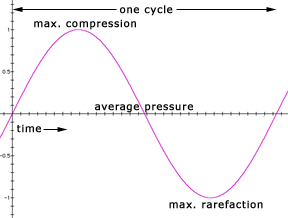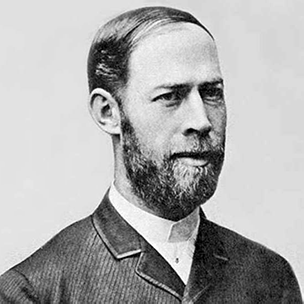Chapter One: An Acoustics Primer

4. What are the characteristics of sound waves?
Sound waves can be characterized by four basic qualities (though many more are related). These are:
- frequency
- amplitude
- waveshape
- phase*
Some sound waves are periodic, in that the change from equilibrium (average atmospheric pressure) to maximum compression to maximum rarefaction back to equilibrium is repetitive. The 'round trip' back to the starting point just described is called a cycle. Periodic wave motion, regardless of its complexity, is characterized as being continuously repetitive.
Periodic motion depends on two prime factors; 1) elasticity, in that the medium being distorted returns to its original state (equilibrium), and 2) a source of energy to initiate and sustain motion. In the case of sound waves, the atmospheric pressure will return to the ambient pressure without an energy source to disturb it, and any vibrating surface will constitute an energy or excitation source.

CYCLE
The 'round trip' back to the starting point just described is called a cycle. A cycle is traditionally graphed as a function of time or distance.

MEASUREMENT
The cycle measurement need not be taken from the zero crossing points, but can be made from any point on the wave that eventually returns to its origin.
It is possible to measure frequency in seconds per cycle or periods, but it is far more common for sound measurements to use cycles per second or simply cps. A "seconds per cycle" or period measurement is the inverse of a "cycles per second" measurement; two seconds per cycle equates to 0.5 cycles per second, and two cycles per second yields 0.5 seconds per cycle. Additionally, one hertz (abbr. Hz–note capitalization) equals 1 cycle per second...they are synonymous and interchangeable values used to convey frequency.

Hertz (Hz)
The official international (SI) measurement for cycles per second as of 1960 is the hertz, abbreviated Hz. It is named in honor of Heinrich Rudolph Hertz, a 19th-century German physicist credited with definitively proving the existence of electromagnetic waves, earlier predicted by James Maxwell, and their propagation in space as radio waves. Hertz was a student of Helmholtz, mentioned earlier in this text.
*A single waveform's phase is usually not discernible at audio rate, but becomes a factor when two or more waves of differing phase are played simultaneously, or when a single waveform is used at a very slow rate as a control signal in synthesis to create, for example, vibrato.